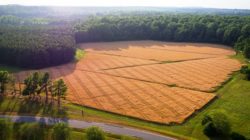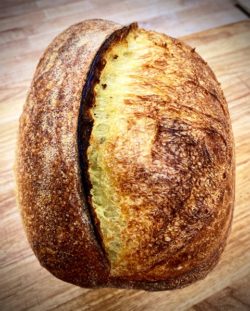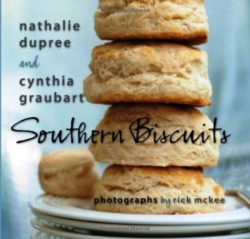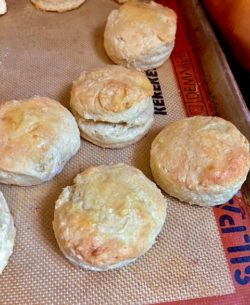Read Time: 6 Minutes Subscribe & Share
A Retirement Plan
 When Cathy and Fred Sachs were planning retirement, the couple wanted to keep their home in Alexandria but also have a country place. They fell in love with the area around the Rappahannock River near Montross, Virginia and chose some acreage, long worn out from years of conventional farming. Corn, beans and wheat, with perhaps some dairy thrown in on the side were typical crops. The fields had lain fallow for years. Romantically, Cathy and Fred named it Grapewood Farm after the prevalence of wild grapes growing in the woods.
When Cathy and Fred Sachs were planning retirement, the couple wanted to keep their home in Alexandria but also have a country place. They fell in love with the area around the Rappahannock River near Montross, Virginia and chose some acreage, long worn out from years of conventional farming. Corn, beans and wheat, with perhaps some dairy thrown in on the side were typical crops. The fields had lain fallow for years. Romantically, Cathy and Fred named it Grapewood Farm after the prevalence of wild grapes growing in the woods.
City Slickers
Once they had their house designed and built, the Sachs family began to look at the possibilities of the surrounding property more closely. The once arable land was quite overgrown as well as exhausted, and at first the Sachs leased one field to a neighbor, who, as David Sachs wrote me “was kind enough to teach us the basics of farming…We started with just one field…and very little knowledge.”
of farming…We started with just one field…and very little knowledge.”
The Sachs family decided to make a commitment to pursue organic certification of their fields and faced a very steep learning curve. With their decision to try to grow wheat, they purchased a small tabletop mill simply to grind flour for their own use. They were all struck by the incredible flavor of the flour and would occasionally present some extra to friends and family. And then came the flow of requests.
This beautiful area of Virginia is also a hotbed of independent food producers, and the Sachs family began to get requests for flour or even wheat berries, which could be ground and used by bakers. And so they grew! A new barn was built, and by 2018 they had even constructed a commercial-scale mill (no more 4-inch hopper on a table). Their wheat harvests had waiting lists from local bakers, pasta makers and chefs.
We Are More Than Flour
 The family, over the last four years, has experimented with different certified organic grains. In 2022, Grapewood Farm has not only harvested four varieties of wheat and rye, but also introduced some ancient grains as well – notably emmer and spelt. The latter, by the way, is noted for its more digestible gluten content than that of wheat, because spelt gluten is water soluble, whereas the gluten in wheat is not.
The family, over the last four years, has experimented with different certified organic grains. In 2022, Grapewood Farm has not only harvested four varieties of wheat and rye, but also introduced some ancient grains as well – notably emmer and spelt. The latter, by the way, is noted for its more digestible gluten content than that of wheat, because spelt gluten is water soluble, whereas the gluten in wheat is not.
While the Sachs did not have a Biodynamic landscape architect, such as Alan York featured in the documentary The Biggest Little Farm, they immersed themselves in the lengthy and convoluted organic certification process outlined by the USDA – which prohibits the use of chemicals and herbicides.They then followed a more intensive initiative from the Rodale Institute. This commitment requires a three-year rotation plan in which fields “recover” with a nutrient-dense crop, which is turned back into the earth. David said that they also have learned to practice high mowing and try to keep tillage to a minimum.
Grapewood Farm now has its own system of composting, which we all know returns a universe of micro-organisms back to the earth to enhance the healthy growth of plants. One of the remarkable projects of the Sachs family has been to set aside a wildlife area on the farm itself. This, too, is somewhat on the biodynamic spectrum, as it provides another avenue of natural protection against crop infestations.
 David wrote that it started with “installing nesting boxes for Wood Ducks, considered by many to be the most beautiful bird in America. We even created wildlife borders around each crop field to increase quail habitats, pollinators and insects. That led to a diversity of fruits, with the hope of attracting more birds, and nesting boxes for migratory osprey. Beaver dams provide the ponds for the wood ducks, and flocks of visiting geese feed on the tender wheat crop over the winter.”
David wrote that it started with “installing nesting boxes for Wood Ducks, considered by many to be the most beautiful bird in America. We even created wildlife borders around each crop field to increase quail habitats, pollinators and insects. That led to a diversity of fruits, with the hope of attracting more birds, and nesting boxes for migratory osprey. Beaver dams provide the ponds for the wood ducks, and flocks of visiting geese feed on the tender wheat crop over the winter.”
Apparently, in addition to the joys of seeing wild turkeys, red tailed hawks, fox, deer, raccoons, eagles and herons, Grapewood is now home to too many ground hogs. Hopefully, their beloved dogs can keep some of them at bay. David’s mother, Cathy, told me that she loves the varieties of songbirds that have gradually taken up transient accommodations at Grapewood.
The Sachs family loves to share their farm and their hard-won knowledge with visitors – and Northern Neck itself has a burgeoning local food scene. They have hosted family and school groups and organizations that focus on reintroducing our nation to sustainable agriculture. As one of the early members of Common Grain Alliance, they want to make us aware of the value of purchasing products like their flour, all grown locally and sustainably, and with flavor. To plan your visit to their farm and to other food producers in Northern Neck, contact the family at: www.grapewoodfarm.com.
Flour Power
I never knew before I went to Sicily that white flour had any particular taste. I did notice ” le goût du chemicals” in grocery store white bread. It’s probably why we slather it with (hopefully) butter or mayo. And yes, with whole wheat, rye etc, you are tasting something other than cotton pillow fluff.  But since then, I have been experimenting with domestic small organic producers of flour, and believe me, you will taste nuttiness, maybe a bit of spice, or even a golden buttery flavor. For example Open Hand Pasta & Provisions at the Old Town Market sells a loaf made with Grapewood Spelt, and it is delicious.
But since then, I have been experimenting with domestic small organic producers of flour, and believe me, you will taste nuttiness, maybe a bit of spice, or even a golden buttery flavor. For example Open Hand Pasta & Provisions at the Old Town Market sells a loaf made with Grapewood Spelt, and it is delicious.
When you go to Grapewood’s online shop, you will have a choice of 1 or 2kg bags (2.2lbs or 4.4lb) except for the varieties of their grain berries, which are sold in 2kg bags.They advise you to store their flours in your refrigerator or freezer to best preserve their flavor and nutrients. All of their flours are grown from certified organic grains. Unsifted flours will have all the bran particles, #70 sifting will have some bran particles, and #90 sifting will have none.
Grapewood’s organic hard winter wheats come with two pecentages of gluten: 9.7 and 11.5. Fred Sachs chose a Polish varity of rye, Danko, and offers it cracked, #70 sifted, and unsifted for baking. Danko rye is very aromatic, light in color and has a delicate flavor. For spelt, Grapewood offers the organic Sungold variety, which is a modern cultivar of this early grain, with a more digestible gluten profile. You have a choice of #70 or #90 sifted or unsifted whole. When you bake with just spelt, it’s wise to use a baking powder or soda (or both), as it will need the extra lift. When it is mixed with a high gluten flour, though, normal baking procedures can be followed.
 Wheat flours fall into soft and hard categories. I use their soft wheat for pastry crusts and biscuits, and have created an “all-purpose” flour by combining the two on a per cup basis, which weighs out at approximately 120- 130 grams -weigh 70 grams of hard flour and 60 grams of soft flour. My husband prefers the #90 sifting version of their flours, as he is not as fond of the bran particles. It remains one of our little disagreements in taste.
Wheat flours fall into soft and hard categories. I use their soft wheat for pastry crusts and biscuits, and have created an “all-purpose” flour by combining the two on a per cup basis, which weighs out at approximately 120- 130 grams -weigh 70 grams of hard flour and 60 grams of soft flour. My husband prefers the #90 sifting version of their flours, as he is not as fond of the bran particles. It remains one of our little disagreements in taste.
There is nothing like an American biscuit to give you a quick sense of what a good flour tastes like, and this one from Nathalie Dupree and Cynthia Graubert’s Southern Biscuits became my primer as I learned how to turn my former hockey pucks into biscuits similar to the ethereal ones my North Carolinian mother-in- law used to make. Good even without butter!


- 2 1/4 cups (281gr) all purpose flour, divided
- 1 tablespoon (14gr) baking powder
- 1 teaspoon salt
- 1/4 cup (57gr)chilled shortening, lard and or butter, cut into 1/4 inch pieces
- AND
- 1/4 cup (57gr) chilled shortening, lard and/or butter cut roughly into 1/2 inch pieces
- 1 cup (60ml) milk or buttermilk, divided
- Butter, softened or melted, for finishing
- Preheat oven to 450F (230C)
- I use a half sheet with a Silpat - if the biscuits are placed close together, you will get softer sides
- Fork or whisk sift 2 cups of flour with the baking powder and salt in your mixing bowl.
- Set aside the remaining 1/4 cup flour and scatter the 1/4 inch pieces of the chilled fat over the flour.
- Using your fingers and thumbs, work the fat into the flour by almost snapping them together repeatedly until the mixture looks like crumbled feta cheese.
- Scatter the second set of pieces and proceed as above until the flour/fat mixture resembles peas and smaller bits.
- You can shake the bowl to let the larger pieces come to the top to check for size of larger bits that need to be snapped into "pea" size".
- Place your bowl in the refrigator for 5 minutes to rechill the fat if this process has taken longer than 5 minutes.
- Make a hollow in the mix and pour 3/4 cup milk into the hollow and with a rubber spatula, scrape quickly around the sides to center to incorporate the milk until the mass is sticky and pulls away from the sides of the bowl.
- If you need more milk to achieve this, add sparingly until the rough mass is in the center - ditto with the flour if the mixture is too sloppy.
- Sprinkle your counter with some of the reserved flour and turn onto the surface and add a bit of the flour to the top of your mass.
- With floured hands, pat the dough quickly into a rough rectangle and fold in half - then pat it out so that the dough is about 1/2 inch thick (you can use additional flour if needed).
- Fold a second time and pat out to a 1/2 inch or 1 inch thickness, depending on how high you like your biscuits to be.
- Brush away excess flour before cutting with a floured cutter or knife - always cut from the outside edge inward, as the less reshaping your dough undergoes, the more tender the resulting biscuits will be.
- I try not to twist the cutter and transfer the biscuits to the baking sheet.
- Bake the biscuits on the top half of the oven about 12-18 minutes; you may want to rotate the pan after about 6 minutes.
- Your biscuits should be lightly golden before removing them from the oven and then brush with the butter.
- Put them in a cloth lined basket and serve immediately!
- Although, many cooks use a cast iron skillet, this did not work out for me, as the bottoms were too brown for our taste.
- This looks like a lot of instructions but I pared them down from the original book (which is excellent). Who knew that such a delicious and simple-seeming recipe could be so finicky!
- Once you get the hang of it, you won't look at these directions anymore.
- I have tried a variety of shortenings, and prefer all butter.
- My favorite baking powder is from Bakewell Cream in Maine.

Kitchen Detail shares under the radar recipes, explores the art of cooking, the stories behind food, and the tools that bring it all together, while uncovering the social, political, and environmental truths that shape our culinary world.




Comments are closed here.
Follow this link to create a Kitchen Detail account so that you can leave comments!